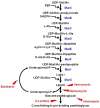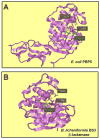Beta-lactam antibiotics: from antibiosis to resistance and bacteriology
- PMID: 20041868
- PMCID: PMC2894812
- DOI: 10.1111/j.1600-0463.2009.02563.x
Beta-lactam antibiotics: from antibiosis to resistance and bacteriology
Abstract
This review focuses on the era of antibiosis that led to a better understanding of bacterial morphology, in particular the cell wall component peptidoglycan. This is an effort to take readers on a tour de force from the concept of antibiosis, to the serendipity of antibiotics, evolution of beta-lactam development, and the molecular biology of antibiotic resistance. These areas of research have culminated in a deeper understanding of microbiology, particularly in the area of bacterial cell wall synthesis and recycling. In spite of this knowledge, which has enabled design of new even more effective therapeutics to combat bacterial infection and has provided new research tools, antibiotic resistance remains a worldwide health care problem.
Figures






References
-
- Bottcher HM. A history of antibiotics. Philadelphia: JB Lippincott Company; 1964.
-
- Burdon S. Memoirs: The origin and distribution of microzymes (bacteria) in water, and the circumstances which determine their existence in the tissues and liquids of the living body. 1871:323–52.
-
- Lister J. A contribution to the germ theory of putrefaction and other fermentative changes, and to the natural history of torulae and bacteria. Trans R Soc Edinburg. 1875;27:313.
-
- Roberts W. Studies of biogenesis. Philos Trans R Soc Lond. 1874;164:457–77.
Publication types
MeSH terms
Substances
Grants and funding
LinkOut - more resources
Full Text Sources
Other Literature Sources
Medical

